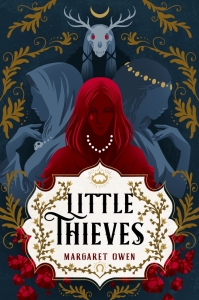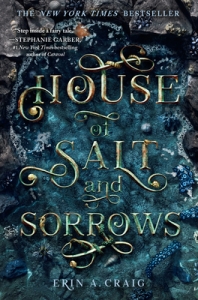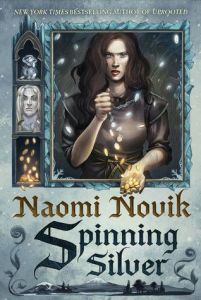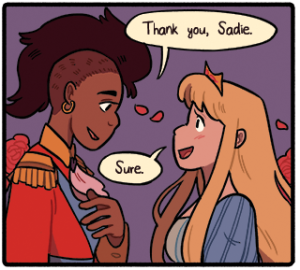Title: Nettle & Bone
Author: T. Kingfisher
Genre: Fairy Tale
Trigger Warnings: Death, child death, grief, domestic abuse, murder, violence, blood, cannibalism (mentions), animal death (mentions), pregnancy, childbirth
Back Cover:
After years of seeing her sisters suffer at the hands of an abusive prince, Marra—the shy, convent-raised, third-born daughter—has finally realized that no one is coming to their rescue. No one, except for Marra herself.
Seeking help from a powerful gravewitch, Marra is offered the tools to kill a prince—if she can complete three impossible tasks. But, as is the way in tales of princes, witches, and daughters, the impossible is only the beginning.
On her quest, Marra is joined by the gravewitch, a reluctant fairy godmother, a strapping former knight, and a chicken possessed by a demon. Together, the five of them intend to be the hand that closes around the throat of the prince and frees Marra’s family and their kingdom from its tyrannous ruler at last.
Review:
I put this on my TBR list for a reason, I assume. However, by the time I actually got around to reading it, I didn’t remember that reason. And as I tend to do with books that are on my TBR list, I didn’t even bother to read the back cover before I started reading. So I really had no idea what to expect going into it. So I was pleasantly surprised with how enjoyable it happened to be and how much it felt like a genuine fairy tale, albeit a darker one.
The story moves very fast and seems shorter than it is. It goes back and forth between past and present, showing Marra’s quest to kill the abusive prince as well as the backstory – her life as a third-born princess and how she decided killing the prince was the way to go in the first place. It was a little confusing at the beginning as it went back and forth. Both storylines were interesting, but the backstory was told out of order so it wasn’t always clear where events fit in the timeline. Once I got oriented a bit better, I managed to fit the outlines of the story together and enjoyed it a lot.
I was somewhat expecting a YA book (I have a tendency to gravitate towards those in general) and all the accompanying tropes. So I was pleased to find that not only is this not YA, Marra turns all of the protagonist tropes on their head. She’s thirty years old. She hates being a princess not because she wants her freedom or anything, but because it’s a lot of pressure and politics and she’d rather knit and embroider at the convent. She’s incredibly innocent and considers herself a coward, but doesn’t recognize exactly how much she is willing to go through to save her sister. And as a final interesting bit, she’s slightly below average in mental faculties and aware of it, which was interesting and unique and in its own way a bit refreshing. She was a fantastically interesting and unique character, and also quite easy to like, if just slightly too bland to adore.
The rest of Marra’s questing party were quite fun. I loved the grouchy, powerful, knowledgeable old woman, and her relentless matter-of-factness was fantastically entertaining. The former knight who was trapped in fairyland for a while and not sure what to do now was okay, but incredibly bland – notable for being muscular and vaguely kind, but not possessing much in the way of personality. The fairy godmother was a later addition to the party, but she was relentlessly cheery and I enjoyed her quite a bit too. The chicken possessed by a demon and the dog made of bones who hasn’t really figured out he’s dead were both fun (mildly amusing and completely adorable, respectively), but were both more like pets than actual characters, no matter what the back cover said.
The plot moves very fast and the book seems a lot shorter than it is. The three “impossible tasks” are over and done with fairly early. It alternates the quest to collect allies and kill the prince who murdered one sister and is abusing the other with Marra’s upbringing as a third princess and in the convent. Despite the past having significantly less plot than the present, I found it just as interesting. All of the story itself was very good. It’s the details where things start to struggle, and most of them I noticed more in retrospect.
The magic was fairy tale-ish but the system was vague, which was fine for the kind of story this is. I really couldn’t get a sense of the world beyond “generic medieval-ish fantasy,” and even with Marra growing up in a convent I only got the vaguest sense of one minor deity-ish being. It was … fine, but I think there could have been more done with it. Also with the demon-possessed chicken – there’s a lot of potential in that idea that never played out. And there’s an interesting theme about trying to force people to receive your help when they don’t want it. It’s a very worthwhile message and an interesting idea to contemplate, but I don’t think Marra ever actually learned the lesson so I’m not sure it really counts as a theme in the first place.
Despite the shortcomings, I very much enjoyed the book. It struggles in the details, but the problems are easy to overlook while reading. Usually when a book has two storylines, I prefer one over the other, but both the past and present stories in this one were enjoyable, which is unusual and deserves major props. I appreciated a protagonist who isn’t whip-smart and is just honestly trying her best. It was a solid plot, good characters in general, a great protagonist, a mostly happy ending, some fun and interesting ideas, and some good emotions. The details may be lacking in retrospect, but it doesn’t affect the reading experience, and on the whole it’s a very good read.











